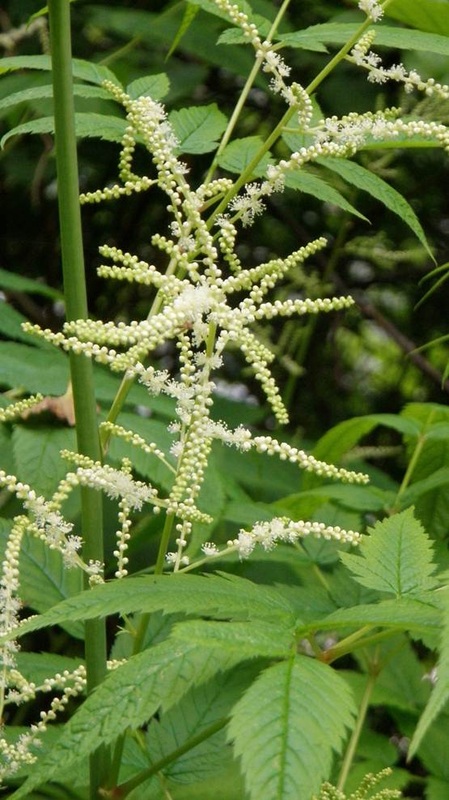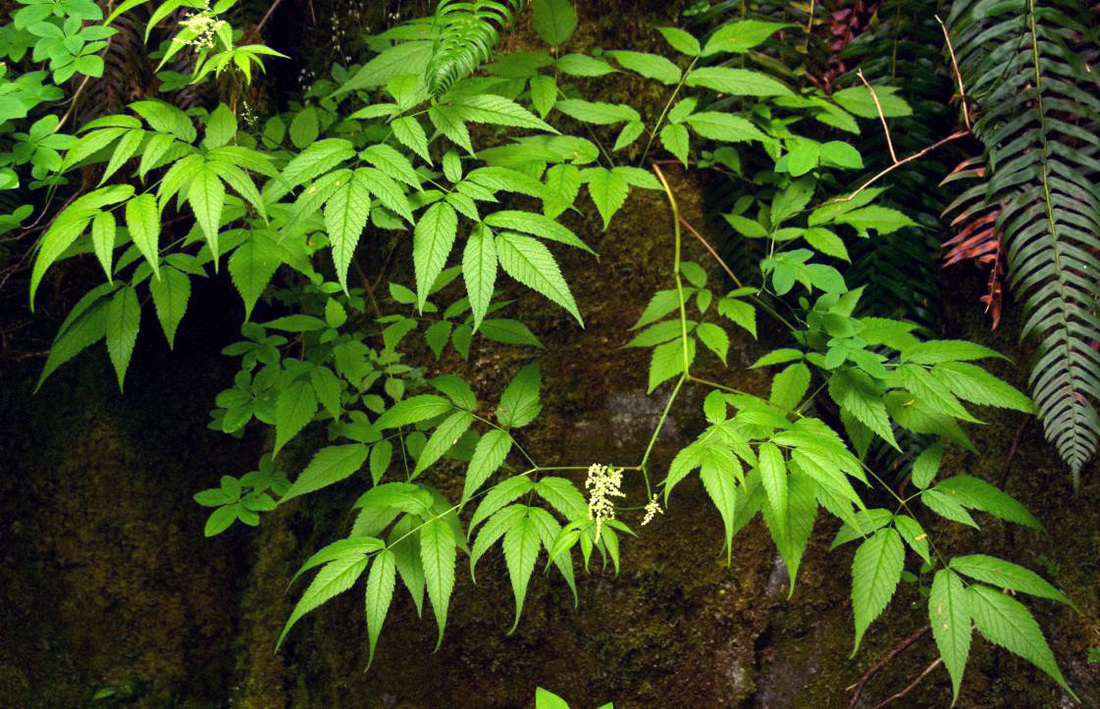Goatsbeard, bride's feathers • Aruncus dioicus
Identification
Goatsbeard is a 1-2 m tall perennial with oblong to egg shaped, pointed, and sharply double-toothed leaves. Lower leaves are larger, hairy, paler and three times compound, while the upper leaves are smaller, hairless, greener, and less compound. The tiny flowers for which goatsbeard is named are white and densely packed in distinctive elongated spike-like clusters. The straw-coloured fruits hang off branches in long narrow clusters.
Habitat & Range
Goatsbeard tends to inhabit 'edge' habitats at low to middle elevations, including moist ravines, avalanche tracks, rocky ledges, streambanks, and forest openings. Its Pacific coast range extends from Alaska south to California; it is common in most of coastal BC but rare north of the North Coast.
Human Uses
Many parts of goatsbeard have varying traditional medicinal uses in coastal First Nations cultures. The roots were used to treat blood diseases, swelling and internal bleeding, and during childbirth, while twigs were prepared into a slave for sores, swellings, and sore throats.
Goatsbeard is a 1-2 m tall perennial with oblong to egg shaped, pointed, and sharply double-toothed leaves. Lower leaves are larger, hairy, paler and three times compound, while the upper leaves are smaller, hairless, greener, and less compound. The tiny flowers for which goatsbeard is named are white and densely packed in distinctive elongated spike-like clusters. The straw-coloured fruits hang off branches in long narrow clusters.
Habitat & Range
Goatsbeard tends to inhabit 'edge' habitats at low to middle elevations, including moist ravines, avalanche tracks, rocky ledges, streambanks, and forest openings. Its Pacific coast range extends from Alaska south to California; it is common in most of coastal BC but rare north of the North Coast.
Human Uses
Many parts of goatsbeard have varying traditional medicinal uses in coastal First Nations cultures. The roots were used to treat blood diseases, swelling and internal bleeding, and during childbirth, while twigs were prepared into a slave for sores, swellings, and sore throats.
References
Aruncus dioicus (Walter). In Klinkenberg, Brian. (Ed.). E-Flora BC: Electronic Atlas of the Plants of British Columbia. Lab for Advanced Spatial Analysis, Department of Geography, University of British Columbia, Vancouver. Accessed 21/11/2014.
Pojar, J. and MacKinnon, A. (1994). Plants of Coastal British Columbia, including Washington, Oregon, and Alaska. Vancouver, BC: Lone Pine Publishing. P 182.
Authors and editors of page
Paige Whitehead, Kelly Fretwell, and Brian Starzomski (2014).
Aruncus dioicus (Walter). In Klinkenberg, Brian. (Ed.). E-Flora BC: Electronic Atlas of the Plants of British Columbia. Lab for Advanced Spatial Analysis, Department of Geography, University of British Columbia, Vancouver. Accessed 21/11/2014.
Pojar, J. and MacKinnon, A. (1994). Plants of Coastal British Columbia, including Washington, Oregon, and Alaska. Vancouver, BC: Lone Pine Publishing. P 182.
Authors and editors of page
Paige Whitehead, Kelly Fretwell, and Brian Starzomski (2014).






